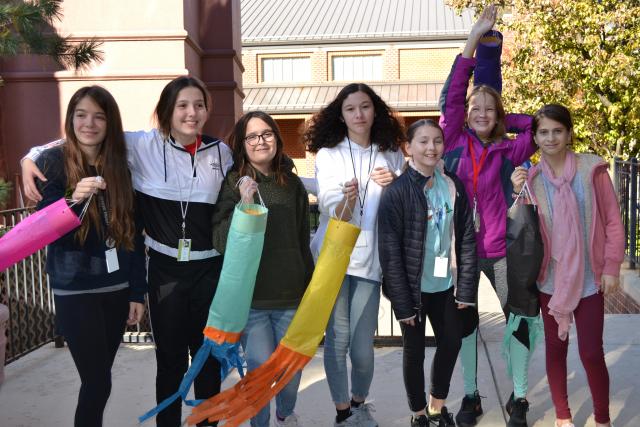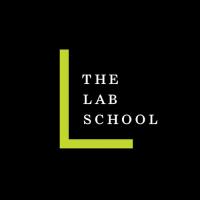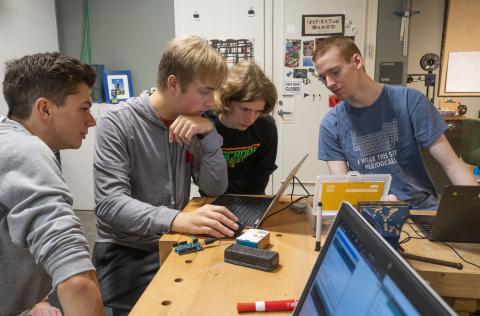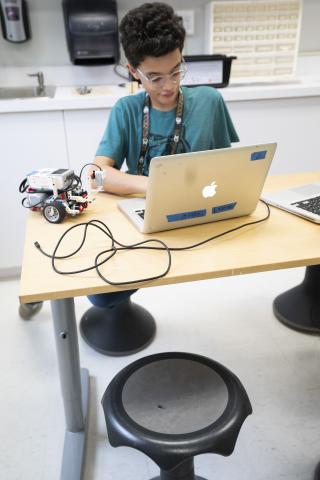

Lab School Engineering
The Why Behind the Design Process
“Learning to master these skills is a significant goal in and of itself. But another whole layer of these classes like Engineering, Robotics, Design Lab, and Metalsmithing emerges from the secondary goals which include the development of skills needed to work effectively in team environments such as risk taking, collaboration, communication, perspective taking, and reflection. All invaluable — and essential — 21st century skills.”
— Director of Educational Technology Daniel Hartmann
The world is changing fast. Not only is technology transforming the way we learn, work, and communicate but the job market seems to be morphing at break-neck speed, too. Daily, it feels, life is being reinvented with a new and ever-shifting menu of opportunities. Thrilling and daunting, indeed.
How best to prepare? Learn through design processes that have real-world applications. The design process demands creative thinking in order to both define and solve problems, A skill set that is emphasized by the 21st century marketplace. At Lab, a focus on project-based, experiential learning across all academic subjects is the norm. But this year, in all divisions, we have added more STEAM (science, technology, engineering, arts, math)-related courses to give students the opportunity to focus on the why behind design processes — whether that process involves building a robot that climbs stairs in Robotics class or formulating an ecocity in Science and Engineering classes where sustainability is its goal.

So, what exactly is design process? In a nutshell, it is an approach for breaking down a large project into manageable chunks. Students — anyone! — can use this process to define the steps needed to tackle a project, while remembering to hold to all of their ideas and sketches throughout the process.
Junior High Robotics Teacher Maria Brinza pushes her students to “slow look” and go back to the proverbial drawing board when something doesn’t work. “Using the Carnegie Mellon Robotics curriculum, my students can visually code with logic and function blocks which mimic written code, making the material more accessible to the way they learn,” she says. “While they are building a robot that can make a U-turn or creating a gearbox on the 3-D printer strong enough for a wind turbine to turn on lights, for example, they are learning why the design process is crucial for success … breaking their process into small steps and using sequential thinking so when something doesn’t work they can return to their code and locate the breakdown.”
In Mr. Hartmann’s Engineering class, there are no grades; it is a portfolio-assessed class. “In one of our first projects of the year, the kids had to design a quad-copter body that could deliver a small package from the first to the second floor of the High School. They had to document all the steps and present their experience to the class. Having to apply design processes to real-world challenges using everyday objects really pushes the students to understand why chunking information, delineating clear steps, and planning sequentially is far more effective than making one big plan and then, oftentimes, having to start anew when it doesn’t work,” he says. “The projects we are doing during the year are designed to show students how the engineering design process can be applied to everyday life. Emphasizing the skills of design process and why they are important teaches students computational thinking and focuses on the real world applications of problem solving.”

For High School Director of Visual Arts and Science Teacher Rebecca Alberts, teaching design process is second nature, especially in her Jewelry Making/Metalsmithing class. “One of the things that is so beneficial for students in the metals class is that it integrates many skills — from design, which involves the joining of formal visual ideas with functionality, and the actual skill building involved with using specialized tools with these materials (silver, copper, brass, stones) to having to slow down, as the materials require that shift in immediacy,” she says. “This class is all about problem solving and it is great to watch students go through the process along with all the challenges involved in designing and then fabricating pieces of functional art.”
Even the younger students are getting in on the design process action. Intermediate Art Teacher Deirdra Hazeley’s Design Lab class focuses on introducing basic 3-D design concepts (see Short page 33), which promotes problem-solving strategies, creative thinking, collaboration, and expression using various sculptural materials. And in three STEAM classes, Elementary is taking on a “First Lego League,” this year’s national challenge being “What if you could build a better world?” The year-long project includes real-world engineering activities as well as an emphasis on teamwork, healthy competition, and core values. “Not only are we excited to take on this challenge as a rich opportunity for collaboration and community-building,” says Head of Elementary Amy Oswalt, “but the choice was intentional as our theme this year is COIL: connection, origin, innovation, and legacy — ideas that can thread through all subjects and which can last a lifetime.”


